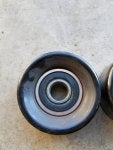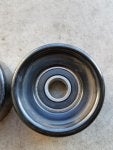The tensioner on my nephews 2007 honda accord is starting to fail. When the radiator fan turns on the tensioner starts making noise and has slight movement (back & forth).
In the past it didn't do this, now it does. He has 151,000 miles with the original tensioner & serpentine belt.
Bought the more expensive honda oem tensioner (31770-PNA-023) $128.32 and bando 7PK1781 $18.72 from Amazon. I didn't want to spend that much for tensioner, but
it lasted 12 years!
In the past it didn't do this, now it does. He has 151,000 miles with the original tensioner & serpentine belt.
Bought the more expensive honda oem tensioner (31770-PNA-023) $128.32 and bando 7PK1781 $18.72 from Amazon. I didn't want to spend that much for tensioner, but
it lasted 12 years!






